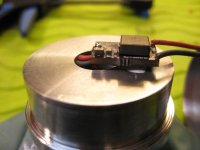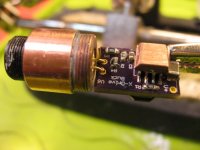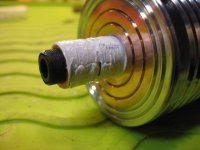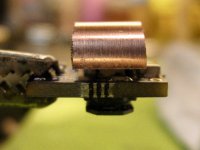The following questions are for using a large heatsink (e.g. host body or diode heatsink) for an SXD driver running at 4+ Amps:
1) Which component(s) of the driver needs to be heatsinked the most? What does that component look like on the board? Since many rectangular driver boards have components on both sides, which side needs to contact the heatsink (face down position) ?
2) If the driver has a potentiometer, is it best to keep the side of the board with the potentiometer face-up for future access to the potentiometer?
3) What is the best way to attach the heatsink (Arctic Silver or another brand)? Or holding the board down mechanically with a bar of some sort?
4) What areas of the board or components should be avoided when applying thermal glue? The legs of the CPU or the tracing on the board or.....?
5) Is it best to apply a thick layer or thin layer of thermal epoxy? I assume thicker means greater electrical insulation from the metal heatsink (good) but greater thermal insulation (bad)?
6) How do I electrically insulate the components of the board since they will be touching the metal heatsink? I think DTR uses a special thin tape ?
7) Has anyone experienced the driver 'popping off' from its location where it was bonded, after the thermal epoxy cured ?
8) What about thermal pads, clay, putty? Are they all the same thing? Has anyone experienced a blob of clay debonding and rattling around inside the host?
9) Is it better to have a driver heatsink which is separate from the diode heatsink so both are not contributing heat to the same heatsink?
10) How much of the total heat is generated at the driver vs. the diode?
11) What is the best way to attach a driver to the inner surface of the battery tube of the host (since the board is flat and the tube is curved)?
12) Generally, which comes first: attaching the leads to the driver or attaching the driver to the heatsink (for convenience and ease of
assembly) ?
1) Which component(s) of the driver needs to be heatsinked the most? What does that component look like on the board? Since many rectangular driver boards have components on both sides, which side needs to contact the heatsink (face down position) ?
2) If the driver has a potentiometer, is it best to keep the side of the board with the potentiometer face-up for future access to the potentiometer?
3) What is the best way to attach the heatsink (Arctic Silver or another brand)? Or holding the board down mechanically with a bar of some sort?
4) What areas of the board or components should be avoided when applying thermal glue? The legs of the CPU or the tracing on the board or.....?
5) Is it best to apply a thick layer or thin layer of thermal epoxy? I assume thicker means greater electrical insulation from the metal heatsink (good) but greater thermal insulation (bad)?
6) How do I electrically insulate the components of the board since they will be touching the metal heatsink? I think DTR uses a special thin tape ?
7) Has anyone experienced the driver 'popping off' from its location where it was bonded, after the thermal epoxy cured ?
8) What about thermal pads, clay, putty? Are they all the same thing? Has anyone experienced a blob of clay debonding and rattling around inside the host?
9) Is it better to have a driver heatsink which is separate from the diode heatsink so both are not contributing heat to the same heatsink?
10) How much of the total heat is generated at the driver vs. the diode?
11) What is the best way to attach a driver to the inner surface of the battery tube of the host (since the board is flat and the tube is curved)?
12) Generally, which comes first: attaching the leads to the driver or attaching the driver to the heatsink (for convenience and ease of
assembly) ?
Last edited:













